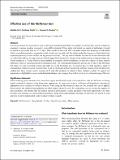Files in this item
Effective use of the McNemar test
Item metadata
| dc.contributor.author | Pembury Smith, Matilda | |
| dc.contributor.author | Ruxton, Graeme D. | |
| dc.date.accessioned | 2020-10-12T10:30:06Z | |
| dc.date.available | 2020-10-12T10:30:06Z | |
| dc.date.issued | 2020-10-10 | |
| dc.identifier | 270484608 | |
| dc.identifier | 62bf1099-98aa-43db-8b97-88de7158387d | |
| dc.identifier | 000576567900001 | |
| dc.identifier | 85092380479 | |
| dc.identifier.citation | Pembury Smith , M & Ruxton , G D 2020 , ' Effective use of the McNemar test ' , Behavioral Ecology and Sociobiology , vol. 74 , 133 . https://doi.org/10.1007/s00265-020-02916-y | en |
| dc.identifier.issn | 0340-5443 | |
| dc.identifier.other | ORCID: /0000-0001-8943-6609/work/82179566 | |
| dc.identifier.uri | https://hdl.handle.net/10023/20769 | |
| dc.description.abstract | It is not uncommon for researchers to want to interrogate paired binomial data. For example, researchers may want to compare an organism’s response (positive or negative) to two different stimuli. If they apply both stimuli to a sample of individuals, it would be natural to present the data in a 2 × 2 table. There would be two cells with concordant results (the frequency of individuals which responded positively or negatively to both stimuli) and two cells with discordant results (the frequency of individuals who responded positively to one stimulus, but negatively to the other). The key issue is whether the totals in the two discordant cells are sufficiently different to suggest that the stimuli trigger different reactions. In terms of the null hypothesis testing paradigm, this would translate as a P value which is the probability of seeing the observed difference in these two values or a more extreme difference if the two stimuli produced an identical reaction. The statistical test designed to provide this P value is the McNemar test. Here, we seek to promote greater and better use of the McNemar test. To achieve this, we fully describe a range of circumstances within biological research where it can be effectively applied, describe the different variants of the test that exist, explain how these variants can be accessed in R, and offer guidance on which of these variants to adopt. To support our arguments, we highlight key recent methodological advances and compare these with a novel survey of current usage of the test. | |
| dc.format.extent | 9 | |
| dc.format.extent | 462541 | |
| dc.language.iso | eng | |
| dc.relation.ispartof | Behavioral Ecology and Sociobiology | en |
| dc.subject | McNemar test | en |
| dc.subject | Binomial data | en |
| dc.subject | P value | en |
| dc.subject | Significance testing | en |
| dc.subject | Meta-analysis | en |
| dc.subject | QH301 Biology | en |
| dc.subject | T-DAS | en |
| dc.subject.lcc | QH301 | en |
| dc.title | Effective use of the McNemar test | en |
| dc.type | Journal article | en |
| dc.contributor.institution | University of St Andrews. School of Biology | en |
| dc.contributor.institution | University of St Andrews. Centre for Biological Diversity | en |
| dc.identifier.doi | 10.1007/s00265-020-02916-y | |
| dc.description.status | Peer reviewed | en |
This item appears in the following Collection(s)
Items in the St Andrews Research Repository are protected by copyright, with all rights reserved, unless otherwise indicated.

